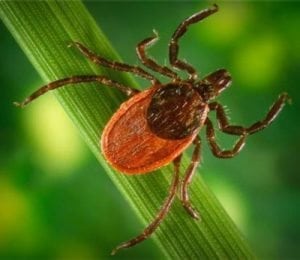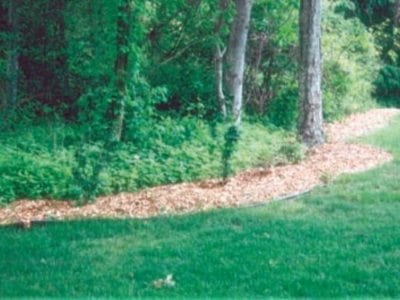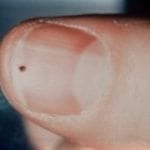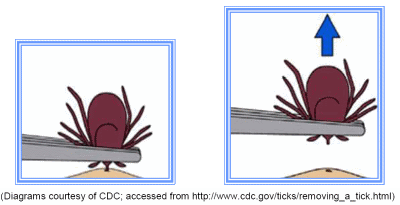Avoid Ticks

CDC / James Gathany
The best way to prevent Lyme disease is to avoid ticks. Stay out of tick habitat, especially areas with long grass, lots of brush or leaf litter. Stay in the center of hiking and biking trails; don’t sit on fallen logs.
Blacklegged ticks cannot bite through clothing. Because wearing long-sleeved shirts, pants and hats minimize exposed skin this strategy helps prevent bites. Ticks do not jump or fall from trees. Instead, they typically crawl to the edge of a leaf or blade of grass and wait for something to brush against them. Once on clothing, they will search until they find the exposed skin to bite.
Landscape with purpose
Many people become infected around their home. Clear away brush and fallen leaves, keep your grass short. Place lawn furniture and play structures in sunny areas of the yard. Bird feeders and wood piles attract tick-carrying mice so keep them far from the house.
Don’t feed deer or use plants that attract them. Below are a few examples of the plants that attract deer as well as a list of those that do not.
Plants that attract deer
- olden sunflowers
- perennial sunflowers
- hostas
- lilies
- tulips
- yew
- arborvitae
- phlox
- Bolton’s aster
- daylily
- euonymus
- impatients
- miniature hollyhocks
Plants that don’t attract deer
- alyssum
- dusty miller
- forget-me-not
- marigold
- spiderflower
- vinca
- catmint
- foxglove
- goldenrod
- lady’s mantle
- lamb’s ear
- lavender
- lily of the valley
- Mint, oregano or thyme
- mayapple
- silvermound
- poppy
- Russian sage
- yarrow
Please see the Tick Management Handbook for more information on landscape management and the creation of tick free zones.

This arrangement puts the person who mows the grass at great risk because they’ll be bumping into the brush where ticks like to hang out.

By putting in a buffer zone, you can cut that risk substantially. Just remember to use nonporous materials that don’t hold moisture.

Ticks dry out easily so they require a habitat that is moist. They prefer the shade and areas where moisture is trapped.

Ticks dehydrate in the sun which can kill them. Put play equipment and outdoor furniture in the sun, not the shade.
An ounce of Permethrin is worth a pound of antibiotics
Use Insecticides and Repellents
Insecticides and repellents reduce the risk of a tick bite. Insecticides kill ticks; repellents encourage them to leave before biting. You should use both to ensure maximal protection.
Permethrin
Permethrin is an insecticide essential to prevention plans. Apply it to clothing, sleeping bags, tents and other gear, but not skin, before entering tick habitat. It remains effective for 2-6 weeks and through multiple washings. Permethrin-embedded clothing retains its effectiveness through 70 washings; tick gaiters are also useful. Permethrin products are sold at outdoor stores and online. Safety information is available by clicking the links below:
There are several repellents available for purchase. Because the effectiveness of most “natural products” hasn’t been proven, look for products with one of these ingredients:
Picaridin
Picaridin is a newer repellent that’s as effective as DEET, use concentrations of 20%. Apply it to unbroken skin, fabrics, and materials. It is non-toxic and safe for children of all ages. Safety information is available by clicking the link below:
DEET
DEET is the best-known repellent, use concentrations of 30% or higher. DEET is safe to apply to unbroken skin, wool and cotton but it can damage other fabrics and materials, such as leather or rubber. The EPA considers DEET to be safe for kids more than 2 months old but Canada’s health department recommends against using DEET on children. Safety information is available by clicking the links below:
- EPA – The Insect Repellent DEET
- EPA – ReRegistration Eligibility Decision (RED) Fact Sheet
- Health Canada – Re-evaluation Decision Document
IR3535
IR3535 is a repellent for use on unbroken skin. It will not hurt fabrics or gear. IR3535 is safe for children of all ages. Unfortunately, it is very short-acting, lasting less than 2 hours. Safety information is available by clicking the link below:
BioUD
BioUD is a newer repellent derived from wild tomato plants. A concentration of 7.75% is 2-4 times more active than 98% DEET against black-legged ticks. It can be used on clothing but doesn’t last as long as permethrin. BioUD is available online at www.homs.com.
Pets need protection too

E.L. Maloney
If you have a dog or indoor/outdoor cats be sure to speak to your vet about the most effective options available to protect your pet.
It is important to note that protecting your pet against ticks does not protect you against the ticks that they may bring into the home.
Tick Checks are Vital

EL Maloney
Check for ticks frequently while in tick habitat and for 1-2 days after potential exposure. Tick checks need to be body-wide. Ideally, you would come in, shower vigorously and then do the check. Studies found that showering within two hours of exposure can reduce the risk of Lyme disease.
A CDC study from 2016 found that putting dry clothes in the dryer on high heat for 10 minutes will effectively kill any ticks found on the clothing. Additional time is needed if the clothes are damp. If the clothing needs to be laundered, be sure to wash and dry on the highest heat setting.
Tick checks are very effective but they must be done carefully and after each exposure. You also need to remember that your target is very small. If you rush through your check, it’s likely you’ll miss seeing ticks.
Promptly remove and save attached ticks in a re-sealable container so your doctor can examine them. Pets that go outdoors can bring ticks indoors; check them for ticks and use appropriate, veterinarian-approved tick products.
The risk of contracting Lyme disease depends on how long the tick was attached and how likely it is to be infected.

IgeneX, Inc., Palo Alto, CA
Few infected ticks transmit Lyme in less than 24 hours. At 48 hours, roughly 15% will transmit; at 60 hours, 50% pass on the infection and when infected ticks feed until full, 94% will transmit Lyme disease. In many high-risk areas, half of the black-legged ticks are infected with Lyme.
Blacklegged ticks may be infected with other diseases and these infections, often called co-infections, are also transmitted through bites. Anaplasmosis, babesiosis and Powassan disease are known as co-infections; bartonellosis may also be transmitted by ticks. Transmission times for most are unknown, some infections are more rapidly transmitted than Lyme disease. Anaplasmosis is transmitted in less than 24 hours and the transmission of Powassan disease can occur in as little as 15 minutes.
Tick Removal
- Grasp tick close to the skin
- Avoid squeezing body
- Pull the tick straight out


